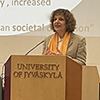The Department of Physics is organising a seminar entitled 'Transcranial Magnetic Stimulation (TMS) and Electromagnetics – Clinical Applications'. The speakers are Dr Mark Xuereb and Dr Lourdes Farrugia.
date: Friday 22 March
time: 12:00 - 14:00
venue: Hall C, Gateway Building, University of Malta Msida Campus
Abstract
In recent years the use of non-ionising electromagnetic fields (EMF) in clinical settings have increased significantly, and the applications are many and varied. Applications range from the treatment and diagnosis of diseases in oncology to the treatment of mental and physical disorders. The interaction of EMF with the human body highly depends on the frequency and this very often defines the clinical application. This is because there are established biophysical mechanisms that describe the interaction of EMF with the human body at different frequencies. At low frequencies (LF), below 100 kHz, exposure to EMF above a certain level provoke reversible effects on excitable cells in the body such as phosphenes, electric charge effects on the skin or stimulation of nerves and muscles which are experienced as a tingling sensation. These effects occur at different thresholds depending on the EMF frequency.
Lecturer and crisis psychiatrist Dr Mark Xuereb will be giving an overview of the use of LF EMF in the treatment of, among others, depression, anxiety, alcohol, cocaine, and nicotine addictions, obsessive compulsive disorder (OCD), as well as migraine, tinnitus, and stroke rehabilitation using Transcranial Magnetic Stimulation (TMS), which he pioneered locally in 2015. This technique has been developed since 1985 and is approved globally by world health bodies such as the Food and Drug Administration (FDA), the British National Institute for Health and Care Excellence (NICE), and the Australia New Zealand Therapeutic Products Authority (ANZTPA). The pathway toward this revolutionary noninvasive treatment has involved a great deal of scientific research and technological advancement. It is still considered as an evolving but revolutionary technology with different types of stimulation (including single pulse, repetitive, and theta-burst) currently used in clinical practice. In addition, numerous solid studies and guidelines show that this revolutionary technology is beneficial, especially when added to the traditional therapies, increasing the effectiveness of available treatments while reducing side effects. This improves the patients' quality of life especially when one considers that depression, anxiety, OCD, addictions and stroke form the bulk of the world’s overall health burden to date.



